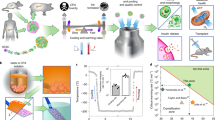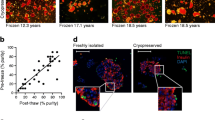Abstract
Cryopreservation of islets of Langerhans offers advantages for the transplantation into diabetic patients. In this study two different methods of cryopreservation were compared with respect to islet viability and recovery after cryostorage. It was also investigated whether human islet survival in mice was affected by cryopreservation. Aliquots of human islets were cryopreserved conventionally or vitrified, respectively. After rapid thawing, islet viability and islet equivalent (IEQ) recovery rate were determined. Aliquots of freshly isolated or conventionally cryopreserved islets were transplanted beneath the kidney capsule of non-diabetic C57BL/6 mice. After three days renal insulin content was determined. Islet cell viability was 17.3±8.0% for vitrified and 51.8±3.0% for conventionally cryopreserved islets; the recovery rate was 84.8±12.2% and 92.8±12.4%, respectively. Insulin recovery after transplantation was 25.6±7.3% for fresh and 24.1±7.4% for cryopreserved islets. This study suggests that the conventional method of cryopreservation is superior to vitrification with respect to islet viability after thawing. We found no significant difference between fresh and cryopreserved islets with respect to insulin recovery after transplantation into mice.
Similar content being viewed by others
Author information
Authors and Affiliations
Rights and permissions
About this article
Cite this article
Langer, S., Lau, D., Eckhardt, T. et al. Viability and recovery of frozen-thawed human islets and in vivo quality control by xenotransplantation. J Mol Med 77, 172–174 (1999). https://doi.org/10.1007/s001090050330
Issue Date:
DOI: https://doi.org/10.1007/s001090050330




